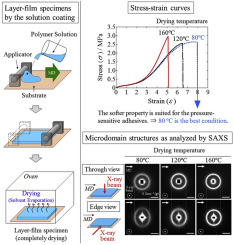Polymer ( IF 4.1 ) Pub Date : 2019-03-02 , DOI: 10.1016/j.polymer.2019.02.052 Takahiro Doi , Hideaki Takagi , Nobutaka Shimizu , Noriyuki Igarashi , Shinichi Sakurai

|
An acrylic block copolymer system is a promising candidate for the functional adhesives bearing good weatherability as well as high transparency. Coated layers of the acrylic block copolymers were prepared by the solution coating method using a polymethylmethacrylate-block-poly(n-butylacrylate)-block-polymethylmethacrylate triblock copolymer (MAM) and a polymethylmethacrylate-block-poly(n-butylacrylate) diblock copolymer (MA). The thickness of the prepared specimens was 50 μm, which is typical of the pressure-sensitive adhesives. Atomic force microscope (AFM) observations and two-dimensional small-angle X-ray scattering (2d-SAXS) measurements were performed to analyze the nano structures and to discuss the effects of the drying temperature on the nano structures. Note that better physical properties were obtained in the specimen prepared at the lower drying temperature. The AFM observations revealed cylindrical morphology for the annealed MAM neat specimen. On the other hand, the 2d-SAXS measurements revealed spherical morphology for all of the specimens including MAM neat and MA/MAM blends. The effects of the drying temperature on the ordering regularity of spheres, d spacing, and radius of sphere has been examined quantitatively. It was found that the ordering regularity of spheres was more improved for the higher drying temperature. As for the behaviors of d and R, the experimental results exhibited very complicated behaviors as a function of the drying temperature. Namely, d and R increased as a function of the drying temperature, which is completely opposite to the general behaviors of the block copolymer microdomain structure as d or R ∝ T −1/3 for the upper critical solution temperature system where the interaction between two kinds of the constituent block chains is decreased with an increase in temperature. The effect of structure freezing during the solvent evaporation was taken into account and such complicated behaviors of experimental results (d and R) could be almost perfectly explained. It is concluded by this study that the poor regularity of the sphere ordering provides softer property with larger elongation at break for the coated film, which is more suitable as the pressure-sensitive adhesives.
中文翻译:

小角X射线散射表明,溶液涂布过程中的干燥温度对由二嵌段共聚物和三嵌段共聚物共混物组成的压敏胶涂层中微相分离结构的影响
丙烯酸嵌段共聚物体系是具有良好耐候性和高透明度的功能性粘合剂的有前途的候选者。丙烯酸系嵌段共聚物的涂覆层通过溶液涂敷用polymethylmethacrylate-方法制备嵌段-聚(ñ - -butylacrylate)嵌段-polymethylmethacrylate三嵌段共聚物(MAM)一个polymethylmethacrylate-和块-聚(Ñ-丙烯酸丁酯)二嵌段共聚物(MA)。制备的样品的厚度为50μm,这是压敏胶粘剂的典型值。进行了原子力显微镜(AFM)观察和二维小角X射线散射(2d-SAXS)测量,以分析纳米结构并讨论干燥温度对纳米结构的影响。注意,在较低的干燥温度下制备的样品获得了更好的物理性能。原子力显微镜的观察揭示了退火过的MAM纯净试样的圆柱形态。另一方面,2d-SAXS测量显示了包括MAM纯净和MA / MAM共混物在内的所有标本的球形形态。干燥温度对球的有序性d的影响间距和球半径已经过定量检查。已经发现,随着干燥温度的升高,球的有序性得到了更大的改善。至于d和R的行为,实验结果显示出非常复杂的行为随干燥温度的变化。即,d和- [R随着干燥温度的函数,这是完全相反的嵌段共聚物微区结构作为一般行为d或- [R α Ť -1/3对于上限临界溶液温度系统,其中两种构成的嵌段链之间的相互作用随着温度的升高而降低。考虑到溶剂蒸发过程中结构冻结的影响,几乎可以完美地解释实验结果(d和R)的这种复杂行为。通过该研究得出的结论是,对于涂层膜而言,较差的球形有序性提供了较软的特性和较大的断裂伸长率,这更适合用作压敏胶粘剂。






























 京公网安备 11010802027423号
京公网安备 11010802027423号